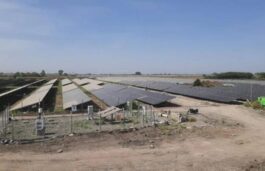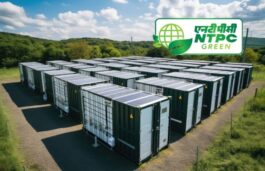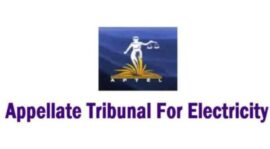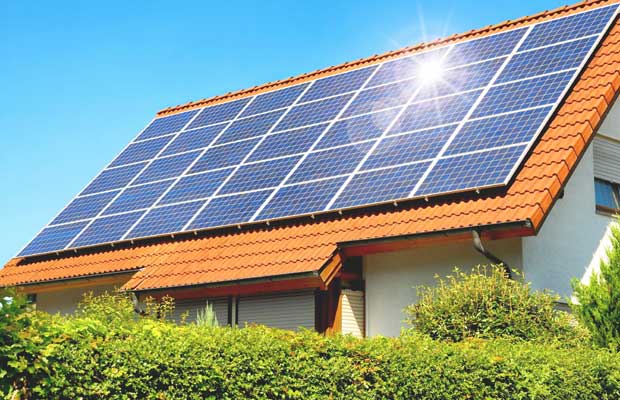

Electricity generated through coal plants is becoming expensive day by day. Power cuts are frequent, and increasing dependence on diesel generators is causing a lot of damage to the environment. The demand-supply gap for electricity is rising in the country which makes it imperative for people to start thinking of other ways of realizing their energy needs. Keeping this in mind, Ministry of New and Renewable Energy (MNRE), Government of India is promoting installation of solar PV rooftop systems under the Jawaharlal Nehru National Solar Mission in India. Many people in the country have started feeling the need of installing solar PV rooftop system for their home, apartment complex or small office use- and with the ‘‘Surge in the Installation of Solar Photovoltaic (PV) Systems around the nation’’ have underscored the importance of cost-effective operations and maintenance practices across the country to boost the lifecycle of solar plants.
More than a thousand homes and business houses across India are using rooftop solar photovoltaic (PV) systems to generate clean, safe and reliable electricity. With promising plans of the government to commission renewables by 2022, half of the rooftop installations are said to enter the phase of maturity, whereas few would be completing more than one year of operation. A rooftop solar power system is a low maintenance and long lived asset for home or business, but it’s not entirely set-and-forget though. As the solar PV systems become older, Operation and Maintenance (O&M) of it becomes more and more important for improving the performance. It is no accident that solar operations and maintenance services have received heightened attention from the worldwide solar community.
Purchasing a solar power system is a significant investment for most of us. It is advisable for households and business houses to undertake research to ensure that they choose a quality system suiting their household needs and budget. After your solar photovoltaic (PV) system has been installed, you should check that you have received all the necessary documentation from your installer, and have also looked into the tweaked meter matching the correct tariff for your suggested electric bill. PV installation lifetimes are expected to be more than 20 years; hence, safe and proper maintenance is an integral part of the successful and reliable operation. System operations and maintenance (O&M) is a broad area and is the continuing focus of service industry, government and national laboratory groups that are working to define the issues better and develop consensus approaches.
After installing the solar system, installer is likely to leave details of maintenance checks that should be carried out at regular intervals to make sure that everything is working to requirements. The information left by the installer should include details of the main inverter fault signals and key troubleshooting guidance along with solar panel cleaning steps. Some solar manufacturers and installers also offer a maintenance package or contract.
Solar O&M services will encompass performing preventative maintenance on the main components of a solar PV system:
• Solar Panels
• Battery
• Charge Controller
• Inverter
• Wiring and connections
Solar Panel Maintenance
The solar panel is often thought to be maintenance free. However, occasional maintenance and inspection of the solar array must be performed to ensure the optimal use of the solar panels. This can be done by keeping the surface area of the module clean from any excess dirt. Since there are no moving parts, solar panels require little maintenance. BUT a buildup of dust, dirt (including ash), gum resin and bird’s nature calls on your solar panels can affect the efficiency and energy output of your system by up to 15%. Rain will wash some of this residue away in time, and your system will continue to operate without being cleaned, but to keep your system working at its full potential a periodic clean can be worthwhile. The cleanliness of the modules should be verified every three months – check for accumulation of debris, dust or fungus on, around and under the array. There should also be a check to ensure that no shading of the array is beginning to occur; for example, due to surrounding tree growth.
It is recommended for the solar panel owners to inspect the structure at regular intervals for dirt or some other things that might have piled on top. It is important that the panels should be kept clean. Also, make sure before cleaning the panels yourself, you should consult with the installer about the warranty conditions. Some solar panel manufacturers could terminate the warranty if any self-cleaning is done.
MAINTAINING AND CLEANING THE SOLAR PANELS:
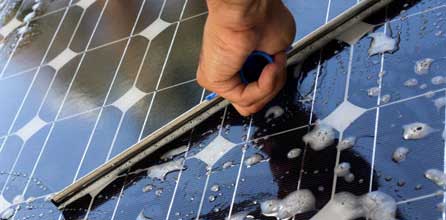
• For a general cleaning, you can just use an ordinary garden hose to wash the face of the panels. You should do this in the morning or evening.
• Also, avoid spraying them with cold water while they are hot because that might damage them.
• If the panels need some more cleaning that the hose cannot provide, you can use a sponge to scrub them.
• Solar panel owners can also get the services of O&M personnel. This is advisable if the panels are too high or need more thorough cleaning.
• AVOID using a metal brush to clean solar panel surface, neither the detergents.
• A visual inspection of the modules can then be done to check for defects in the modules such as cracks, chips, de-lamination, fogged glazing, water leaks and discoloration.
• Ensure the panels and supporting frames are firmly secured.
• The junction boxes should also be checked to make sure that rodents or insects do not chew the wires.
• Make sure that the fittings and cables at the panels and the inverter remain securely attached.
Battery Maintenance
Batteries should be regularly and carefully maintained to extend their useful life. It is advisable for the users to conduct inspections and cleaning of batteries at regular intervals. A visual inspection is recommended to assess the general condition of the system’s battery. Make sure to check for any electrolyte leak, cracks in the batteries, or corrosion at the terminals and connectors. The batteries should be kept clean, dry and free of electrolyte and corrosion residue. Cleaning should be done once in a month. Also, it should be borne in mind that before performing maintenance work, each component of the system should be isolated. This includes switching off circuit breakers to and from the battery bank and the solar panels.
Battery maintenance also involves checking the cell electrolyte level for correct acid volume once a month. Solar panel owners are recommended to use only distilled water to top up the batteries. Another important measure in determining the battery state of charge is the checking battery voltage. After measuring each battery’s voltage, it should be recorded and maintained in a log sheet.
Charge Controller/Regulators
Most of the renewable energy sources require Charge Controller/Regulators. It should be kept in mind that any controller or regulator needs to be installed in a dry, clean and ventilated space. The Charge Controller/Regulators is an electronic device that facilitates in controlling the voltage of the charging sources energy output to the installed battery bank. The regulators have been designed specifically in a manner to disconnect or reduce the charge current when preset voltages are reached. Typically there are boost voltage settings and float voltage configuration. When inspecting the regulators:
• Inspect the controller/regulators for any loose wiring on the terminal connections. If wires are loose follow the shutdown procedures for the system before tightening the connections or either contact your installer to do the task.
• Do not forget to remove any excess dust from the unit and also from the heat sinks. This cleaning process should be carried only with a dry cloth or brush.
• Note that the charge controller should indicate that the system is charging when the sun is up. If not, contact the installer immediately.
• Full operation tests might need to be undertaken by a suitably qualified person e.g. the system supplier/ installer.
Inverter Maintenance
The inverter should be installed in a clean, dry, and ventilated area which is separated from, and not directly above, the battery bank. While the system is operating the following operational checks can be made:
• Visually inspect inverters for any damage.
• Check connections for resistive joints.
• Check the DC voltage applied to inverter input.
• Ensure that there is free space around
the units for cooling purposes.
• Check for all the indicators such as LED lights are working and that the wires leading to and from this device are not loose.
• This component can be maintained by minimizing dust accumulation. A dry cloth should be used to wipe away any accumulated dirt/dust.
• Review the inverter display panel for any recorded faults (refer to the manufacturer’s instructions for advice).
• Make sure that the cooling vents of the inverter are clear of debris.
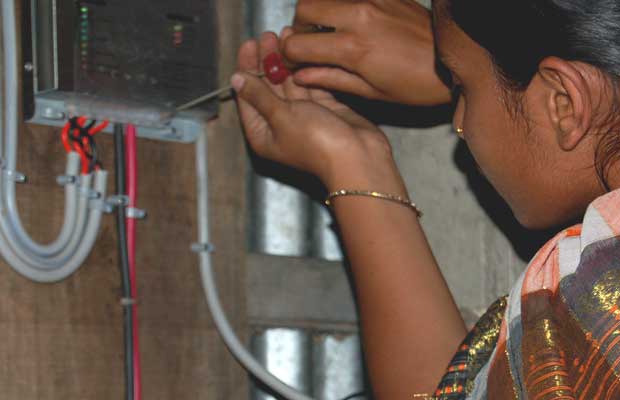
Wiring and Connections
It is advisable to check the Wiring installations for any cracks, breaks or deterioration in the insulation/conduits. Make sure to inspect the panel boxes to check for unwanted rodents and insects. Also, examine the connections for any corrosion or burning. Switches should not spark when turned on or off. The following sections of conduit and wiring should be checked for any signs of damage:
• Solar panels to the charge controller
• Charge controller to the battery bank
• Inverter/charger to the battery bank
• Generator to Inverter/Charger
• Inverter/charger and Generator to the AC outlets
• Battery back to the DC outlets/load
Solar Monitoring Devices and Services
Another method to make sure that your rooftop solar PV system is delivering required output is through monitoring systems and services. For a monthly fee or a flat upfront cost, solar panel owners can monitor how their system is performing.
• The solar panel systems are expected to produce a certain amount of power during each month. Monitoring the solar system can tell you if it is offline or if it is not performing as expected and facilitates in running diagnostic programs.
• Solar monitoring systems can at times prove to be educational, showing the users how much power they have saved, and how much CO2 and how much money can be saved.
• Depending on the monitoring systems, users can access their information from the web, from a wall mounted device, or even from their compatible smartphones.
• Setting monitoring systems are usually an extra expense, whether as a monthly service or purchased up front. While not essential, the monitoring systems do make troubleshooting and system performance easier to see.
Cautions and Preventions
• Take adequate precautions while doing maintenance of the solar panels since these are located on rooftops and there is the risk of falling off.
• Solar power systems are safe when operating correctly. However, there are potentially dangerous hazards associated with some system components.
• Any service required to the wiring must be undertaken by a suitably licensed electrical worker or contractor.
• Refer to system user manual provided by system supplier for exact procedures relevant to your system.
Here are some simple checks that can be performed by the owners:
Daily: Check that solar system has been operational, either by reading the inhouse display or by reading numbers from the inverter’s screen. If it has been a sunny day, you should expect around 4kWh per kW of the capacity of the system. On cloudy days the system will produce the output less than this.
Quarterly: Be noticed that panels are not shaded by the nearby trees or other objects that might barricade the path for sun rays. Check for dust, debris leaves; and make sure to clean it else hire trained personnel to do the job.
Annually: Some daily and weekly checks can be done by oneself, but it is also recommended to consider arranging trained certified professionals and EPCs.
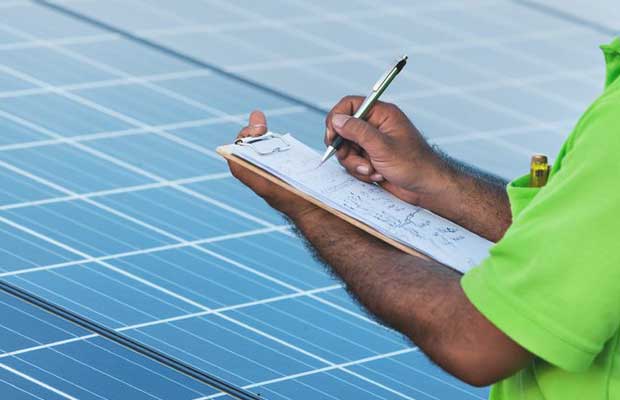
By installing a solar PV system, you need to take responsibility for it and learn the basic safe operation and proper maintenance of your system. Always engage with qualified personnel to undertake maintenance work on your solar PV system.
The solar power system should be regularly maintained and serviced to ensure this valuable investment is working at optimum performance levels. While a solar panel is free of any moving parts, it is entirety robust – requiring little outlay regarding care – by ensuring recommended maintenance and monitoring, the performance of a solar system and its expected service life can be preserved.
• Periodic inspection will help pick up any minor or potential faults, and ensure that the system is performing as it should.
• The periodic maintenance must be carried out by the original installer or another accredited PV contractor or EPCs, who will carry out a range of system checks in line with the standards set by the ministry.
• Perform a general check of performance over the year by referring to the available automated monitoring data or on-site records.
Solar PV systems are like any electrical equipment and need to be regularly maintained for safe and efficient use. Regular maintenance should be carried out in accordance with the manufacturer’s instructions. Proper maintenance ensures that solar system life is preserved for as long as possible, and the original conditions of the systems are sustained, while compensating for normal wear and tear. Solar systems require little maintenance as compared to other electric systems such as diesel generators; however, always remember that they are not maintenance free – they too need to be checked, inspected and maintained.


